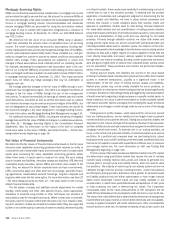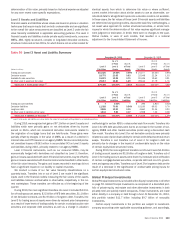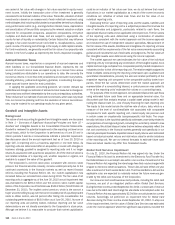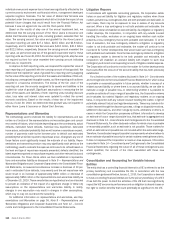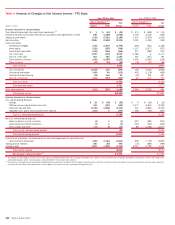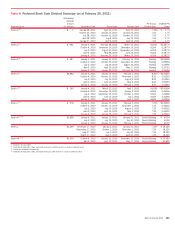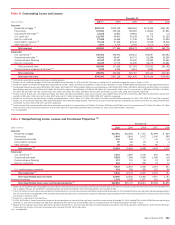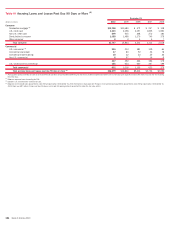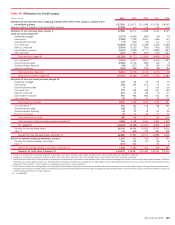Bank of America 2010 Annual Report Download - page 119
Download and view the complete annual report
Please find page 119 of the 2010 Bank of America annual report below. You can navigate through the pages in the report by either clicking on the pages listed below, or by using the keyword search tool below to find specific information within the annual report.Determining whether an entity has a controlling financial interest in a VIE
requires significant judgment. An entity must assess the purpose and design
of the VIE, including explicit and implicit contractual arrangements, and the
entity’s involvement in both the design of the VIE and its ongoing activities.
The entity must then determine which activities have the most significant
impact on the economic performance of the VIE and whether the entity has
the power to direct such activities. For VIEs that hold financial assets, the
party that services the assets or makes investment management decisions
may have the power to direct the most significant activities of a VIE. Alter-
natively, a third party that has the unilateral right to replace the servicer or
investment manager or to liquidate the VIE may be deemed to be the party
with power. If there are no significant ongoing activities, the party that was
responsible for the design of the VIE may be deemed to have power. If the
entity determines that it has the power to direct the most significant activities
of the VIE, then the entity must determine if it has either an obligation to
absorb losses or the right to receive benefits that could potentially be
significant to the VIE. Such economic interests may include investments in
debt or equity instruments issued by the VIE, liquidity commitments, and
explicit and implicit guarantees.
On a quarterly basis, we reassess whether we have a controlling financial
interest and are the primary beneficiary of a VIE. The quarterly reassessment
process considers whether we have acquired or divested the power to direct
the activities of the VIE through changes in governing documents or other
circumstances. The reassessment also considers whether we have acquired
or disposed of a financial interest that could be significant to the VIE, or
whether an interest in the VIE has become significant or is no longer signif-
icant. The consolidation status of the VIEs with which we are involved may
change as a result of such reassessments. Changes in consolidation status
are applied prospectively, with assets and liabilities of a newly consolidated
VIE initially recorded at fair value. A gain or loss may be recognized upon
deconsolidation of a VIE depending on the carrying amounts of deconsoli-
dated assets and liabilities compared to the fair value of retained interests
and ongoing contractual arrangements.
2009 Compared to 2008
The following discussion and analysis provides a comparison of our results of
operations for 2009 and 2008. This discussion should be read in conjunction
with the Consolidated Financial Statements and related Notes. Tables 6 and 7
contain financial data to supplement this discussion.
Overview
Net Income
Net income totaled $6.3 billion in 2009 compared to $4.0 billion in 2008.
Including preferred stock dividends, net loss applicable to common share-
holders was $2.2 billion, or $(0.29) per diluted share. Those results com-
pared with 2008 net income available to common shareholders of $2.6 billion,
or $0.54 per diluted share.
Net Interest Income
Net interest income on a FTE basis increased $1.9 billion to $48.4 billion for
2009 compared to 2008. The increase was driven by the improved rate
environment, the acquisitions of Countrywide and Merrill Lynch, the impact of
new draws on previously securitized accounts and the contribution from
market-based net interest income which benefited from the Merrill Lynch
acquisition. These items were partially offset by the impact of deleveraging
the ALM portfolio earlier in 2009, lower consumer loan levels and the adverse
impact of nonperforming loans. The net interest yield on a FTE basis de-
creased 33 bps to 2.65 percent for 2009 compared to 2008 due to the
factors related to the core businesses as described above.
Noninterest Income
Noninterest income increased $45.1 billion to $72.5 billion in 2009 com-
pared to 2008. Card income on a held basis decreased $5.0 billion primarily
due to higher credit losses on securitized credit card loans and lower fee
income driven by changes in consumer retail purchase and payment behavior
in the stressed economic environment. Investment and brokerage services
increased $6.9 billion primarily due to the acquisition of Merrill Lynch partially
offset by the impact of lower valuations in the equity markets driven by the
market downturn in late 2008, which improved modestly in 2009, and net
outflows in the cash funds. Investment banking income increased $3.3 billion
due to higher debt, equity and advisory fees reflecting the increased size of
the investment banking platform from the acquisition of Merrill Lynch. Equity
investment income increased $9.5 billion driven by $7.3 billion in gains on
sales of portions of our CCB investment and a $1.1 billion gain related to our
BlackRock investment. Trading account profits (losses) increased $18.1 bil-
lion primarily driven by favorable core trading results and reduced write-downs
on legacy assets partially offset by negative credit valuation adjustments on
derivative liabilities of $662 million due to improvement in the Corporation’s
credit spreads. Mortgage banking income increased $4.7 billion driven by
higher production and servicing income of $3.2 billion and $1.5 billion. These
increases were primarily due to increased volume as a result of the full-year
impact of Countrywide and higher refinance activity partially offset by lower
MSR results, net of hedges. Gains on sales of debt securities increased
$3.6 billion due to the favorable interest rate environment and improved credit
spreads. Gains were primarily driven by sales of agency MBS and CMOs. The
net loss in other decreased $1.6 billion primarily due to the $3.8 billion gain
from the contribution of our merchant processing business to a joint venture,
reduced support provided to cash funds and lower write-downs on legacy
assets offset by negative credit valuation adjustments recorded on Merrill
Lynch structured notes of $4.9 billion.
Provision for Credit Losses
The provision for credit losses increased $21.7 billion to $48.6 billion for
2009 compared to 2008 reflecting further deterioration in the economy and
housing markets across a broad range of property types, industries and
borrowers. Net charge-offs totaled $33.7 billion, or 3.58 percent of average
loans and leases for 2009 compared with $16.2 billion, or 1.79 percent for
2008. The increased level of net charge-offs is a result of the same factors
noted above.
Noninterest Expense
Noninterest expense increased $25.2 billion to $66.7 billion for 2009 com-
pared to 2008. Personnel costs and other general operating expenses rose
due to the addition of Merrill Lynch and the full-year impact of Countrywide.
Additionally, noninterest expense increased due to higher litigation costs
compared to the prior year, a $425 million pre-tax charge to pay the U.S. gov-
ernment to terminate its asset guarantee term sheet and higher FDIC insur-
ance costs including a $724 million special assessment in 2009.
Income Tax Expense
Income tax benefit was $1.9 billion for 2009 compared to expense of
$420 million for 2008 and resulted in an effective tax rate of (44.0) percent
compared to 9.5 percent in the prior year. The change in the effective tax rate
from the prior year was due to increased permanent tax preference items as
well as a shift in the geographic mix of our earnings driven by the addition of
Merrill Lynch.
Bank of America 2010 117







